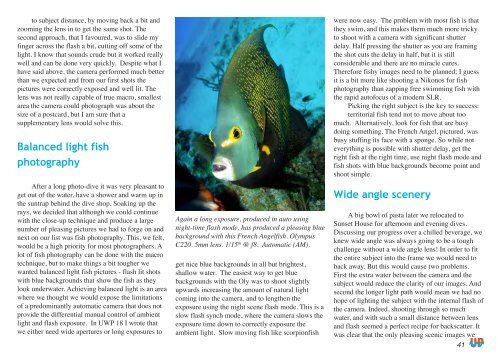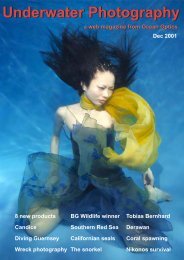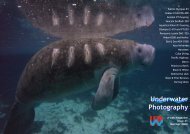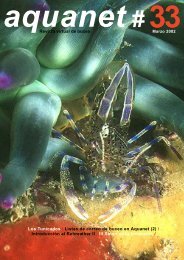Underwater Photography - SENSACIONES.org
Underwater Photography - SENSACIONES.org
Underwater Photography - SENSACIONES.org
You also want an ePaper? Increase the reach of your titles
YUMPU automatically turns print PDFs into web optimized ePapers that Google loves.
to subject distance, by moving back a bit and<br />
zooming the lens in to get the same shot. The<br />
second approach, that I favoured, was to slide my<br />
finger across the flash a bit, cutting off some of the<br />
light. I know that sounds crude but it worked really<br />
well and can be done very quickly. Despite what I<br />
have said above, the camera performed much better<br />
than we expected and from our first shots the<br />
pictures were correctly exposed and well lit. The<br />
lens was not really capable of true macro, smallest<br />
area the camera could photograph was about the<br />
size of a postcard, but I am sure that a<br />
supplementary lens would solve this.<br />
Balanced light fish<br />
photography<br />
After a long photo-dive it was very pleasant to<br />
get out of the water, have a shower and warm up in<br />
the suntrap behind the dive shop. Soaking up the<br />
rays, we decided that although we could continue<br />
with the close-up technique and produce a large<br />
number of pleasing pictures we had to f<strong>org</strong>e on and<br />
next on our list was fish photography. This, we felt,<br />
would be a high priority for most photographers. A<br />
lot of fish photography can be done with the macro<br />
technique, but to make things a bit tougher we<br />
wanted balanced light fish pictures - flash lit shots<br />
with blue backgrounds that show the fish as they<br />
look underwater. Achieving balanced light is an area<br />
where we thought we would expose the limitations<br />
of a predominantly automatic camera that does not<br />
provide the differential manual control of ambient<br />
light and flash exposure. In UWP 18 I wrote that<br />
we either need wide apertures or long exposures to<br />
Again a long exposure, produced in auto using<br />
night-time flash mode, has produced a pleasing blue<br />
background with this French Angelfish. Olympus<br />
C220. 5mm lens. 1/15 th @ f8. Automatic (AM).<br />
get nice blue backgrounds in all but brightest,<br />
shallow water. The easiest way to get blue<br />
backgrounds with the Oly was to shoot slightly<br />
upwards increasing the amount of natural light<br />
coming into the camera, and to lengthen the<br />
exposure using the night scene flash mode. This is a<br />
slow flash synch mode, where the camera slows the<br />
exposure time down to correctly exposure the<br />
ambient light. Slow moving fish like scorpionfish<br />
were now easy. The problem with most fish is that<br />
they swim, and this makes them much more tricky<br />
to shoot with a camera with significant shutter<br />
delay. Half pressing the shutter as you are framing<br />
the shot cuts the delay in half, but it is still<br />
considerable and there are no miracle cures.<br />
Therefore fishy images need to be planned; I guess<br />
it is a bit more like shooting a Nikonos for fish<br />
photography than zapping free swimming fish with<br />
the rapid autofocus of a modern SLR.<br />
Picking the right subject is the key to success:<br />
territorial fish tend not to move about too<br />
much. Alternatively, look for fish that are busy<br />
doing something. The French Angel, pictured, was<br />
busy stuffing its face with a sponge. So while not<br />
everything is possible with shutter delay, get the<br />
right fish at the right time, use night flash mode and<br />
fish shots with blue backgrounds become point and<br />
shoot simple.<br />
Wide angle scenery<br />
A big bowl of pasta later we relocated to<br />
Sunset House for afternoon and evening dives.<br />
Discussing our progress over a chilled beverage, we<br />
knew wide angle was always going to be a tough<br />
challenge without a wide angle lens! In order to fit<br />
the entire subject into the frame we would need to<br />
back away. But this would cause two problems.<br />
First the extra water between the camera and the<br />
subject would reduce the clarity of our images. And<br />
second the longer light path would mean we had no<br />
hope of lighting the subject with the internal flash of<br />
the camera. Indeed, shooting through so much<br />
water, and with such a small distance between lens<br />
and flash seemed a perfect recipe for backscatter. It<br />
was clear that the only pleasing scenic images we<br />
41
















